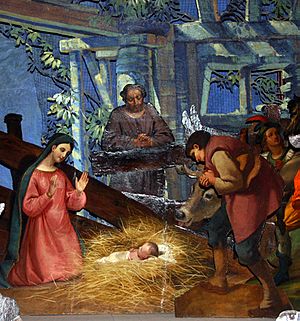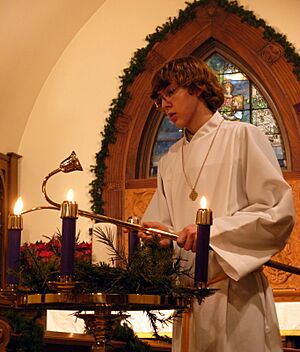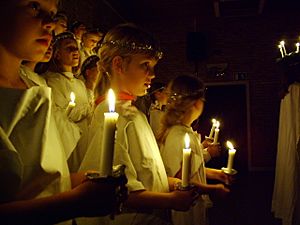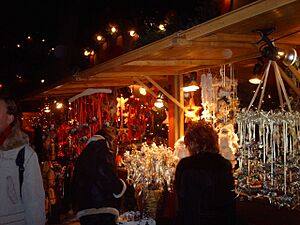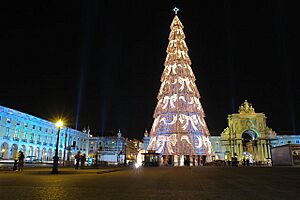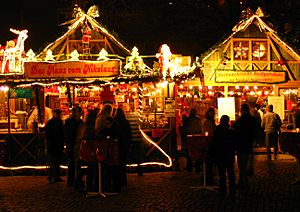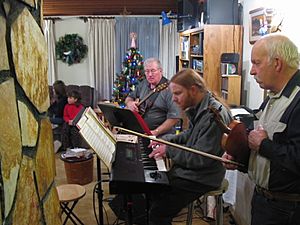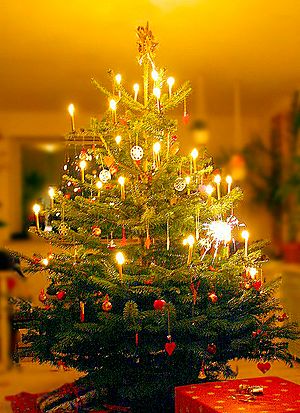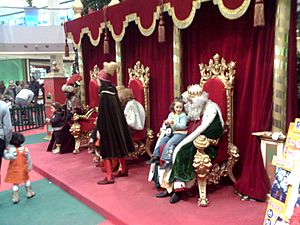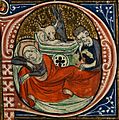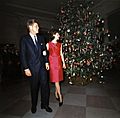Christmas facts for kids
Quick facts for kids Christmas |
|
|---|---|
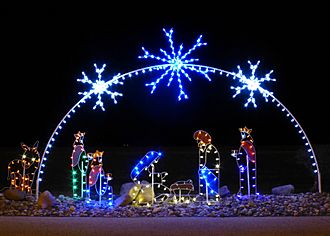
Nativity scene depicted using Christmas lights
|
|
| Also called | Noël, Nativity, Xmas |
| Observed by | Christians, many non-Christians |
| Type | Christian, cultural |
| Significance | Commemoration of the Nativity of Jesus |
| Celebrations | Gift-giving, family and other social gatherings, symbolic decoration, feasting etc. |
| Observances | Church services |
| Date |
|
| Frequency | Annual |
| Related to | Christmastide, Christmas Eve, Advent, Annunciation, Epiphany, Baptism of the Lord, Nativity Fast, Nativity of Christ, Old Christmas, Yule, St. Stephen's Day, Boxing Day |
Christmas means "Feast day of Christ." It is a special holiday for Christians. They celebrate the birth of Jesus, whom they believe is the Son of God. Many non-Christians also celebrate Christmas as a cultural holiday.
Christmas is celebrated on December 25th. It is one of the most important days for Christians. Another key day is Easter, when Jesus' death and resurrection are remembered. The time of getting ready for Christmas is called Advent. It starts about four weeks before Christmas Day. The Christmas Season, known as Christmastide, ends on January 6th. This day is called Epiphany.
People celebrate Christmas all over the world. It can be a religious holiday or a time of celebration for everyone. Traditions change from country to country. But they almost always include a big feast, giving gifts or cards, and enjoying church or public parties. Singing Christmas carols and songs is also common. Santa Claus is a popular tradition in many places.
Christmastide happens in the winter in the Northern Hemisphere. This was a time when old festivals already existed. Some Christmas traditions are actually older than Christmas itself. They come from other non-Christian celebrations, like Yule. Today, Christmas often focuses on giving gifts. Stores start selling gifts, food, greeting cards, Christmas trees, and decorations about a month before Christmas Day.
The Story of Christmas
How the Gospels Tell the Story

Christmas celebrates the birth of Jesus. The story of his birth is found in parts of the Bible called the Gospels. There are four Gospels that tell about Jesus' life. The Gospel of Luke shares the most details about his birth. The Gospel of Matthew tells another part of the story. The Gospel of John explains that Jesus came from God to bring his message to all people.
The Gospels say that long before Jesus was born, prophets told the Jewish people that God would send them a Messiah. This Messiah would be a holy teacher. Christians believe that Jesus was this promised Messiah. His mother was a young woman named Mary. She was engaged to a carpenter named Joseph, but they were not yet married. Joseph was worried when he found out Mary was pregnant. An angel from God appeared to him. The angel told him that the baby was special and holy. The angel said Joseph must name the baby Jesus. This meant Joseph would care for Jesus as his own child.
At that time, the Middle East was ruled by the Romans. An order was given that everyone had to travel to their hometown. They needed to sign up for taxes. So, Joseph took Mary to Bethlehem. There was no room for them to stay anywhere except a stable where animals slept. This is where baby Jesus was born. Joseph named him Jesus, just as the angel had said.
Baby Jesus had two groups of visitors. On the night he was born, angels told some shepherds in the fields about a newborn king. They would find him lying in an animal's feed bin, called a manger. Jesus' other visitors were some wise men. They saw a new star in the sky and followed it. They found the house where the family was living. They gave the young child expensive gifts. These gifts were gold, incense, and a special herb called myrrh. People often call these wise men the Three Kings. This is because there were three very expensive gifts. But the Bible does not say exactly how many wise men there were.
All these parts of the Christmas story are remembered. They are celebrated in many ways at Christmas. You can see them in pictures, songs, plays, stories, and in models. These models are called "cribs," "creches," or "presepe."
When is Christmas Celebrated?
Most Christian countries use the Gregorian calendar. But some churches use the Julian calendar. Most Christians, like those in the Catholic and Protestant Churches, celebrate Jesus' birth on December 25th.
The Eastern Orthodox Church still uses the Julian calendar in some places, like Russia. In these areas, Christmas is on December 25th by their calendar. But because of the difference between calendars, this date is January 7th on the modern Gregorian calendar.
Some Christians, like Jehovah's Witnesses, do not celebrate Christmas. This is because the Bible does not tell Christians to celebrate Jesus' birth. Mormons celebrate Christmas on December 25th. However, they believe Jesus was actually born on April 6th.
Some people believe Jesus was probably not born on December 25th. Some historians think this date was chosen by the Catholic Church. It might have been used to replace older pagan celebrations that happened around that time of year.
What is Advent?
The Season of Advent starts on a Sunday about four weeks before Christmas Day. It is celebrated by Catholic and Anglican Churches, among others. It is a time for people to get ready for two things. First, for the coming of baby Jesus and Christmas. Second, for the future return of Jesus, when he will rule the Earth in peace. Not all Christians observe Advent. Some use it for fasting, study, meditation, and prayer. Special Advent Calendars are made for children. They have pictures or treats for each day of Advent.
Advent is often a very busy time for many people. They prepare for Christmas Day by cleaning and decorating. They buy food and presents, write cards, and cook the Christmas feast.
How Christmas is Celebrated
Before the 4th century AD, Christians had to worship in secret. The Christmas feast likely began when Constantine was the Emperor of Rome. He made Christianity a legal religion. He also built some of Rome's oldest churches. Old stone coffins from this time show carvings of Mary and baby Jesus and the Wise Men.
During the Middle Ages, Christmas was celebrated with feasting, singing, and plays. These plays were held in churches, castles, and market places. Sometimes a big hay wagon was used as a stage.
Advent was a time for prayer and preparation. So, most parties happened after Christmas, not before. The main celebration before Christmas was the Feast of St. Nicholas on December 6th. In some countries, especially the Netherlands, children received presents on this day instead of Christmas Day. The name Saint Nicholas is now remembered in many countries as Santa Claus.
Another celebration is the Feast of Saint Lucy (St. Lucia Day) on December 13th. This is very popular in Scandinavia. Girls take part in parades with candles. The daughters of the house wake up early to bring coffee or chocolate to their family.
For many centuries, Christmas celebrations often started with a church service or mass. This service lasted from late at night until after midnight on Christmas morning. Christmas Day was a time for feasting. On the next day, the Feast of Saint Stephen, rich households would give boxes of food to the poor and hungry. Many people went back to work, but employers gave money gifts to their workers. The holy days continued with the feast of Saint John and Holy Innocents' Day. The feasting and parties ended on the Feast of the Epiphany. This is the day of the Three Wise Men, often called the "Three Kings." The season is now remembered by the song "The Twelve Days of Christmas." William Shakespeare wrote a play for this celebration, called "Twelfth Night".
For many people, Christmas has become a time for parties, sending messages, and giving presents. These things have become more important than celebrating Jesus' birth. Stores and manufacturers respond with lots of advertising, decorations, and displays. In the US, Christmas displays go up right after Thanksgiving in late November. In some countries, like Australia, stores put up decorations in early November. Many Christians feel uneasy about this focus on money. Jesus himself called people making money in the Jewish Temple "robbers."
Towns and cities celebrate by decorating streets and squares. They also provide Christmas entertainment for shoppers. In countries in the Southern Hemisphere, Christmas is in summer. There is a tradition of outdoor Carol Services. These are often organized by the town. Thousands of people attend them.
Many Christians celebrate Christmas by going to church. They also have prayers and singing. Each year, there are Bible readings from the Gospels that tell the story of Jesus' birth.
Christmas Traditions
Christmas traditions come in different types. There are church traditions, public celebrations, and family traditions. These traditions can be different depending on the time, place, culture, and even within families.
Church Traditions
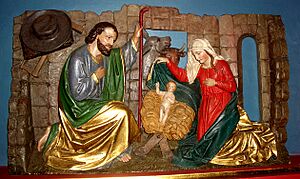
Christmas is a very important time for churches. Almost every church has special services or celebrations. Here are some ways churches celebrate Christmas.
The Christmas Crib
Many churches set up a Crib, also called a Creche, scene. This shows the Nativity, or birth of Jesus. The first scene like this was set up by St. Francis of Assisi in the 13th century. They have been very popular in Italy ever since. The custom has spread to other countries.
Nativity scenes can be very large with life-sized statues. Or they can be tiny enough to fit in a matchbox. They are made from many different materials. These include carved wood, brightly colored pottery, painted paper, and mixtures of clay, cloth, straw, and metal.
The Advent wreath is a circle of leaves. It usually has pine branches, ivy, and holly. It has four (or sometimes five) candles. It is hung in a church. The candles are lit on each Sunday in Advent. The middle candle is lit on Christmas morning. Churches are often decorated with green branches and leaves. Many churches also have a Christmas tree.
Carols by Candlelight
A popular church tradition is the Carol Service. It is often lit only by candles. The carol service usually has lots of singing and Bible readings. In England, a tradition started at the Temple Church in London. It has now spread to many other places. It is a service of Nine Lessons and Carols. The lessons are Bible readings. Some carols are sung by a choir. Others are sung by the choir and the people (the congregation). Every year, one of these services is recorded in a large English Church. Often it is King's College Chapel, Cambridge. It is broadcast on radio and television. Many people enjoy it, especially those who love good music and carol singing. It is also for people who cannot go to a Christmas service.
Public and Shopping Celebrations
Many cities and towns celebrate Christmas by putting up decorations. These can be banners and bunting hung from buildings or lampposts. They can also be Christmas lights that decorate buildings and street trees. Many large cities put up a huge Christmas tree in a public place. Examples are Trafalgar Square in London, Times Square in New York, and Martin Place in Sydney. This is often combined with asking people to give money or gifts to help the poor.
In many cities, shopping hours are made longer before Christmas. This gives workers more time to buy Christmas food and presents. Shop windows are often decorated with Christmas scenes. Large department stores often have moving scenes to entertain children. Shopping malls and big stores often have a Santa Claus. He sits on a throne, and children tell him what they want for Christmas. They can also have their photos taken with him.
Many towns hold Christmas parades, street entertainment, and concerts. Some towns have a tradition of carols with a choir and entertainers in the town hall. In Australia and New Zealand, these concerts are usually held outdoors. They happen in parks or even on beaches. Families bring picnics. Santa Claus often arrives at the end of the evening. This is usually followed by a firework display.
Theatre entertainment is a traditional part of Christmas. This includes classical music performances, like Handel's Messiah. There are also orchestral concerts and band recitals. Pantomimes are often performed at Christmas. Favorites include "Peter Pan and Wendy" and "Cinderella". Many children's movies are released during the Christmas season.
Many people feel lonely, hungry, or sad at Christmas. So, many cities, churches, charities, and service groups try to help them. They provide Christmas food and gifts for poor families. They also hold Christmas parties for people who are hungry or lonely.
Family Celebrations
Family celebrations can be very different. They depend on where a family comes from. They also depend on the customs that have grown in specific families.
Family Gatherings
Most families see Christmas as a time to get together. People often travel far to be with family members at Christmas. Those who cannot travel often make long-distance phone calls on Christmas Day. Many people also invite others who might be lonely to dinner on Christmas Day. Christmas is seen as a time for all ages to have fun. Cousins get to know each other. Grandparents see their grandchildren. Families admire the babies born during the year. Big family parties are usually joyful. But sometimes families talk about disagreements and have fights at Christmas.
Family traditions vary greatly. Some families go to church together. This could be a Carol Service, a Midnight Mass, or a Christmas Morning service. Some families are woken up very early by children who want to open presents. In other families, presents are given on St. Nicholas Day, on Christmas Eve, or after church on Christmas morning. The Christmas feast might start on Christmas Eve. Or it could be a special breakfast on Christmas morning. Or it might be at midday on Christmas Day.
Some families sing carols. They might go around the streets, to hospitals, and other places singing with their church members. Other families like to watch certain television programs together. These might include carol services and the Queen's Message. Some families use Christmas to play music and sing together. Or they might read a favorite book, like "A Christmas Carol" by Charles Dickens. In countries in the Southern Hemisphere, a visit to the beach or a swim in a pool is often part of Christmas Day.
Christmas Dinner
Christmas Dinner is usually eaten in the middle of the day. It is an important part of the family celebration. The food is different from country to country and from family to family. In the Northern Hemisphere, roasted meat and vegetables are usually the main course. Often, several types of meat are served. These might include turkey, ham, roast beef, or lamb. There are often several courses. Special treats are usually only eaten at Christmas.

In English-speaking countries, the traditional dessert is Christmas plum pudding. Today, these are often bought from bakers. But many people make their own using a family recipe. The tradition came from the Middle Ages. The pudding was used to save fruit from autumn until mid-winter. A traditional pudding is baked six weeks before Christmas. It is left tied in a cloth in a cool place. Stirring the pudding is sometimes a family tradition. Everyone makes a wish as they stir. Traditionally, a silver coin would be stirred into the pudding. This was to bring luck to the person who found it. Today, most coins cannot be used because they taste bad and might be unsafe. Some families use old coins or silver charms. On Christmas Day, the pudding must be boiled in a pot for several hours. When it is served, the cloth is cut off. Brandy is poured onto the pudding and set on fire before it is carried to the table.
Many families have a Christmas Cake or a special bread instead of a pudding. Or they might have both. These are very different depending on the country. But they often have Marzipan, made from almonds. Marzipan is traditional in many countries at Christmas. In France, Buche de Noel (Yule log cake) or gingerbread men and women are decorated. They are hung on the Christmas tree. In Scotland, a pastry biscuit called shortbread is made. It has become popular in many countries. A German tradition is pfeffernuss, which are spiced cookies rolled in powdered sugar. Other Christmas foods include raisins, sultanas, ginger, Turkish delight, almonds, chocolates, caramel toffee, candy canes, and oranges.
Many families also prepare mulled wine. This is warmed with cinnamon and nutmeg. Or they make egg nog, a sweet drink made of milk, sugar, eggs, nutmeg, and sometimes alcohol.
In the Southern Hemisphere, the traditional roast dinner is often replaced with cold meats. These are served with salads. The first course might be prawn cocktail or a cold soup like borsch. The plum pudding might be served with ice cream. White wine and beer are served cold. Christmas dinner may be served on the veranda, or sometimes as a picnic.
Tree and Decorations
In most homes where Christmas is celebrated, people set up a Christmas tree. This old custom began in Germany as the "Tannenbaum" (German for Fir Tree). These are traditionally evergreens. The best type is the Fir Tree, which does not lose its needles or its smell. The tree may be a cut tree bought from a farm or taken from the forest. Artificial trees are sometimes chosen instead of real ones. The Christmas tree is decorated with lights, shiny colored balls, sparkly tinsel, and other ornaments. A wreath of leaves or pine is often put on the front door. This is a sign of welcome. Other plants important at Christmas are holly, used for decoration, and mistletoe. Mistletoe is hung in the center of a room. The tradition is that people who meet under the mistletoe must kiss.
Many people decorate their homes at Christmas. These decorations and the Christmas tree are usually inside. But they might be placed where people passing by can see them through a window. In the mid-20th century, people started decorating the outside of houses too. These decorations might be just a few lights around the porch. Or they could be hundreds of lights and colorful Christmas figures decorating the whole house and garden. Some neighborhoods have competitions for the best-decorated house. Driving around to look at them has become another family tradition.
Cards and Presents
The giving of gifts at Christmas comes from several ideas. One is that God gave his son, Jesus, to the world at Christmas. There is also the story of the Wise Men. They came to baby Jesus with three gifts: gold, frankincense, and myrrh. For many centuries, people have given small gifts at Christmas. They also give generously to the poor and needy to help them through winter. Another tradition has become linked to this. The result is the tradition of Santa Claus, or Father Christmas. Many children today believe he brings presents and happiness.
In the 4th century, in a Greek village now part of Turkey, there was a good man. He secretly gave presents to the poor to help them. He became a bishop and is called Saint Nicholas. Over centuries, he became a very popular saint. Many churches were named after him. He was very popular in places with many sailors. One such place was the Netherlands. In the Netherlands and many other European countries, presents are given on the feast of Saint Nicholas, December 6th. Traditionally, the presents are not big. They are sometimes hidden, or come with a funny joke or poem to read. In many European towns, a man dressed in bishop's robes comes on a horse or in a boat. He acts as St. Nicholas. His name was often shortened to Sante Claus, or Santa Claus in English.
In English-speaking countries, presents are usually given on Christmas Day, not December 6th. Santa Claus (or Father Christmas) is usually thought to come on Christmas Night. His magic sleigh is pulled across the sky by reindeer. He comes into houses through the chimney. In Europe, children put out their shoes for St. Nicholas. The English tradition is to hang up stockings (long socks) in front of the fireplace. Santa Claus would traditionally fill the socks or shoes with nuts, raisins, chocolates, and an orange. Today, children usually get much more expensive presents. They hang up pillow cases or have presents in a big pile under the Christmas tree.
Another Christmas tradition is sending cards to friends and relatives. These cards contain warm greetings. They may also have a letter telling about things that happened to the person or family during the year.
Related pages
Images for kids
-
Eastern Orthodox icon of the birth of Christ by Saint Andrei Rublev, 15th century
-
Nativity of Christ, medieval illustration from the Hortus deliciarum of Herrad of Landsberg (12th century)
-
Adoration of the Shepherds (1622) by Gerard van Honthorst depicts the nativity of Jesus
-
Mosaic in Mausoleum M in the pre-fourth-century necropolis under St Peter's Basilica in Rome, interpreted by some as Jesus represented as Christus Sol (Christ the Sun).
-
The Nativity, from a 14th-century Missal; a liturgical book containing texts and music necessary for the celebration of Mass throughout the year
-
The Examination and Tryal of Old Father Christmas, (1686), published after Christmas was reinstated as a holy day in England
-
Ebenezer Scrooge and the Ghost of Christmas Present. From Charles Dickens' A Christmas Carol, 1843.
-
The Queen's Christmas tree at Windsor Castle, published in the Illustrated London News, 1848
-
Many Christians attend church services to celebrate the birth of Jesus Christ.
-
A typical Neapolitan presepe or presepio, or Nativity scene. Local crèches are renowned for their ornate decorations and symbolic figurines, often mirroring daily life.
-
The official White House Christmas tree for 1962, displayed in the Entrance Hall and presented by John F. Kennedy and his wife Jackie.
-
On Christmas, the Christ Candle in the center of the Advent wreath is traditionally lit in many church services.
-
Children in Oklahoma reenact a Nativity play
-
Christmas carolers in Jersey
-
Child singers in Bucharest, 1841
-
Christmas dinner setting
-
A 1907 Christmas card with Santa and some of his reindeer
-
Saint Nicholas, known as Sinterklaas in the Netherlands, is considered by many to be the original Santa Claus
-
Christmas decorations at the Galeries Lafayette department store in Paris, France. The Christmas season is the busiest trading period for retailers.
-
Christmas market in Jena, Germany
-
Each year (most notably 2000) money supply in US banks is increased for Christmas shopping
See also
 In Spanish: Navidad para niños
In Spanish: Navidad para niños


